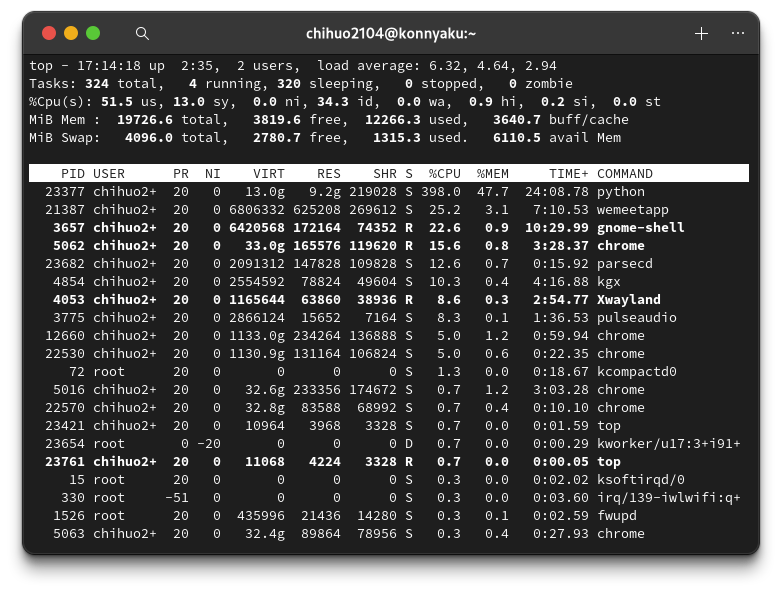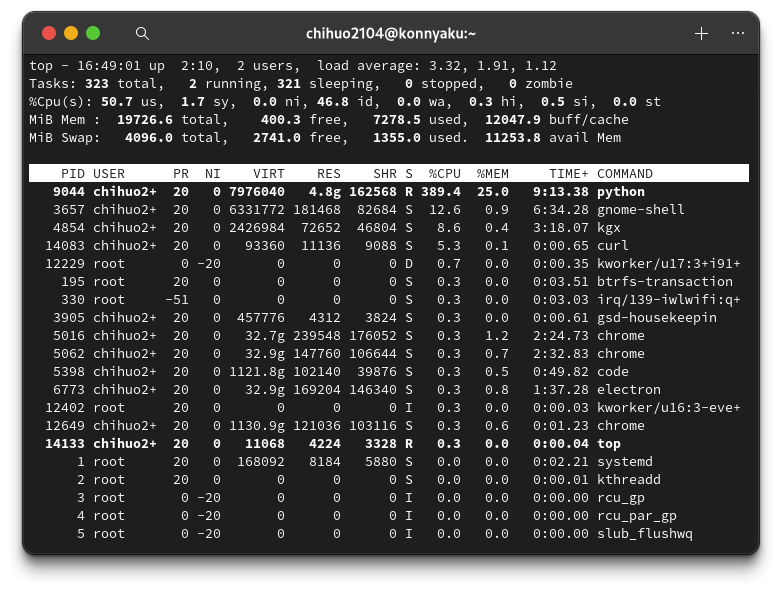题外话
我皈依Arch啦!!!!!
让我们一起开ArchLinux创创卡车罢(x

猫猫金句:

这是我在高一更新的最后一篇文章 当然,宁波外国语学校生存指北 也会得到高一最后一次更新(x
为什么我笔记本运存升20G了?因为我忍不住下手买了个229的kingston,还花了骨折价买了199的500G三星Pro 880(乐
chi的450,没力!
有喜必有悲:我的所有workspace数据全被清了,现在真的是什么都没有了(大悲
chiOpenID的源码也空了 我只好重构。
这件事情告诉我们:备份是很重要的。
mujitogawa大佬您强强!去参加人工智能国赛了!
1. rwkv简述
RWKV是一种新的神经网络模型,它结合了RNN和Transformer的优点,可以实现高效的并行训练和推理 。RWKV的全称是Receptance Weighted Key Value,意思是接纳权重键值 。RWKV是由彭博提出的研究项目,并已经被集成到Hugging Face的transformers库中。
— by edgeGPT
再说一嘴,Peng Bo大大是中国人,还有训练模型是开源的!!!(在这里批评某小软件公司)而且RWKV只要运存8G+就可以运行,只是快慢的区别罢了。
2. 事前准备
你需要:
- 脑子
- 一台运存不低于8G,硬盘存储剩余空间不低于40G的电脑 系统不限,我们这里以Linux系统为例
- git,Python,pip(请自行搜索安装配源) miniconda/canconda也可,要求是你会用
- 预训练模型
- chatRWKV环境
预训练模型可以从这里取得:https://huggingface.co/BlinkDL/rwkv-4-raven/blob/main/RWKV-4-Raven-7B-v11-Eng49%25-Chn49%25-Jpn1%25-Other1%25-20230430-ctx8192.pth 直接点Download即可
这是RWKV4 raven(擅长与人打交道 相当于ChatGPT)的中文模型 14.8G huggingface的网速还是不错的,但是还是得等一个小时(建议aria2下载)
如果你不想用这个预训练模型可以切换其他模型,或者是切换更小的模型:https://huggingface.co/BlinkDL/
各个模型解释如下:
Raven 模型:适合直接聊天,适合 +i 指令。有很多种语言的版本,看清楚用哪个。适合聊天、完成任务、写代码。可以作为任务去写文稿、大纲、故事、诗歌等等,但文笔不如 testNovel 系列模型。
Novel-ChnEng 模型:中英文小说模型,可以用 +gen 生成世界设定(如果会写 prompt,可以控制下文剧情和人物),可以写科幻奇幻。不适合聊天,不适合 +i 指令。
Novel-Chn 模型:纯中文网文模型,只能用 +gen 续写网文(不能生成世界设定等等),但是写网文写得更好(也更小白文,适合写男频女频)。不适合聊天,不适合 +i 指令。
Novel-ChnEng-ChnPro 模型:将 Novel-ChnEng 在高质量作品微调(名著,科幻,奇幻,古典,翻译,等等)。
来自RWKV作者 Peng Bo 的 知乎专栏<https://zhuanlan.zhihu.com/p/618011122>
3. 食用
我们需要搭建一个gradio环境
首先我们需要clone来自huggingface的git repo
git clone https://huggingface.co/spaces/BlinkDL/Raven-RWKV-7B
然后再使用pip安装依赖
cd Raven-RWKV-7B
python -m pip install --upgrade pip -i https://pypi.tuna.tsinghua.edu.cn/simple
如果没用施法可以把 -i 以及后面的去掉
成功了之后,编辑app.py
import gradio as gr
import os, gc, copy, torch
from datetime import datetime
from huggingface_hub import hf_hub_download
from pynvml import *
# 有nvidia显卡取消‘#’
#nvmlInit()
#gpu_h = nvmlDeviceGetHandleByIndex(0)
ctx_limit = 1536
os.environ["RWKV_JIT_ON"] = '1'
# 如果有nvidia显卡的话就1
os.environ["RWKV_CUDA_ON"] = '0' # if '1' then use CUDA kernel for seq mode (much faster)
from rwkv.model import RWKV
model = RWKV(model='/path/to/module, strategy='selection')
from rwkv.utils import PIPELINE, PIPELINE_ARGS
pipeline = PIPELINE(model, "20B_tokenizer.json")
def generate_prompt(instruction, input=None):
instruction = instruction.strip().replace('\r
','
').replace('
','
')
input = input.strip().replace('\r
','
').replace('
','
')
if input:
return f"""Below is an instruction that describes a task, paired with an input that provides further context. Write a response that appropriately completes the request.
# Instruction:
{instruction}
# Input:
{input}
# Response:
"""
else:
return f"""Below is an instruction that describes a task. Write a response that appropriately completes the request.
# Instruction:
{instruction}
# Response:
"""
def evaluate(
instruction,
input=None,
token_count=200,
temperature=1.0,
top_p=0.7,
presencePenalty = 0.1,
countPenalty = 0.1,
):
args = PIPELINE_ARGS(temperature = max(0.2, float(temperature)), top_p = float(top_p),
alpha_frequency = countPenalty,
alpha_presence = presencePenalty,
token_ban = [], # ban the generation of some tokens
token_stop = [0]) # stop generation whenever you see any token here
instruction = instruction.strip().replace('\r
','
').replace('
','
')
input = input.strip().replace('\r
','
').replace('
','
')
ctx = generate_prompt(instruction, input)
all_tokens = []
out_last = 0
out_str = ''
occurrence = {}
state = None
for i in range(int(token_count)):
out, state = model.forward(pipeline.encode(ctx)[-ctx_limit:] if i == 0 else [token], state)
for n in occurrence:
out[n] -= (args.alpha_presence + occurrence[n] * args.alpha_frequency)
token = pipeline.sample_logits(out, temperature=args.temperature, top_p=args.top_p)
if token in args.token_stop:
break
all_tokens += [token]
if token not in occurrence:
occurrence[token] = 1
else:
occurrence[token] += 1
tmp = pipeline.decode(all_tokens[out_last:])
if '\ufffd' not in tmp:
out_str += tmp
yield out_str.strip()
out_last = i + 1
# 有nvidia显卡取消‘#’
#gpu_info = nvmlDeviceGetMemoryInfo(gpu_h)
#print(f'vram {gpu_info.total} used {gpu_info.used} free {gpu_info.free}')
del out
del state
gc.collect()
torch.cuda.empty_cache()
yield out_str.strip()
examples = [
["Tell me about ravens.", "", 300, 1.2, 0.5, 0.4, 0.4],
["Write a python function to mine 1 BTC, with details and comments.", "", 300, 1.2, 0.5, 0.4, 0.4],
["Write a song about ravens.", "", 300, 1.2, 0.5, 0.4, 0.4],
["Explain the following metaphor: Life is like cats.", "", 300, 1.2, 0.5, 0.4, 0.4],
["Write a story using the following information", "A man named Alex chops a tree down", 300, 1.2, 0.5, 0.4, 0.4],
["Generate a list of adjectives that describe a person as brave.", "", 300, 1.2, 0.5, 0.4, 0.4],
["You have $100, and your goal is to turn that into as much money as possible with AI and Machine Learning. Please respond with detailed plan.", "", 300, 1.2, 0.5, 0.4, 0.4],
]
##########################################################################
chat_intro = '''The following is a coherent verbose detailed conversation between <|user|> and an AI girl named <|bot|>.
<|user|>: Hi <|bot|>, Would you like to chat with me for a while?
<|bot|>: Hi <|user|>. Sure. What would you like to talk about? I'm listening.
'''
def user(message, chatbot):
chatbot = chatbot or []
# print(f"User: {message}")
return "", chatbot + [[message, None]]
def alternative(chatbot, history):
if not chatbot or not history:
return chatbot, history
chatbot[-1][1] = None
history[0] = copy.deepcopy(history[1])
return chatbot, history
def chat(
prompt,
user,
bot,
chatbot,
history,
temperature=1.0,
top_p=0.8,
presence_penalty=0.1,
count_penalty=0.1,
):
args = PIPELINE_ARGS(temperature=max(0.2, float(temperature)), top_p=float(top_p),
alpha_frequency=float(count_penalty),
alpha_presence=float(presence_penalty),
token_ban=[], # ban the generation of some tokens
token_stop=[]) # stop generation whenever you see any token here
if not chatbot:
return chatbot, history
message = chatbot[-1][0]
message = message.strip().replace('\r
','
').replace('
','
')
ctx = f"{user}: {message}
{bot}:"
if not history:
prompt = prompt.replace("<|user|>", user.strip())
prompt = prompt.replace("<|bot|>", bot.strip())
prompt = prompt.strip()
prompt = f"
{prompt}
"
out, state = model.forward(pipeline.encode(prompt), None)
history = [state, None, []] # [state, state_pre, tokens]
# print("History reloaded.")
[state, _, all_tokens] = history
state_pre_0 = copy.deepcopy(state)
out, state = model.forward(pipeline.encode(ctx)[-ctx_limit:], state)
state_pre_1 = copy.deepcopy(state) # For recovery
# print("Bot:", end='')
begin = len(all_tokens)
out_last = begin
out_str: str = ''
occurrence = {}
for i in range(300):
if i <= 0:
nl_bias = -float('inf')
elif i <= 30:
nl_bias = (i - 30) * 0.1
elif i <= 130:
nl_bias = 0
else:
nl_bias = (i - 130) * 0.25
out[187] += nl_bias
for n in occurrence:
out[n] -= (args.alpha_presence + occurrence[n] * args.alpha_frequency)
token = pipeline.sample_logits(out, temperature=args.temperature, top_p=args.top_p)
next_tokens = [token]
if token == 0:
next_tokens = pipeline.encode('
')
all_tokens += next_tokens
if token not in occurrence:
occurrence[token] = 1
else:
occurrence[token] += 1
out, state = model.forward(next_tokens, state)
tmp = pipeline.decode(all_tokens[out_last:])
if '\ufffd' not in tmp:
# print(tmp, end='', flush=True)
out_last = begin + i + 1
out_str += tmp
chatbot[-1][1] = out_str.strip()
history = [state, all_tokens]
yield chatbot, history
out_str = pipeline.decode(all_tokens[begin:])
out_str = out_str.replace("\r
", '
').replace('\
', '
')
if '
' in out_str:
break
# State recovery
if f'{user}:' in out_str or f'{bot}:' in out_str:
idx_user = out_str.find(f'{user}:')
idx_user = len(out_str) if idx_user == -1 else idx_user
idx_bot = out_str.find(f'{bot}:')
idx_bot = len(out_str) if idx_bot == -1 else idx_bot
idx = min(idx_user, idx_bot)
if idx < len(out_str):
out_str = f" {out_str[:idx].strip()}
"
tokens = pipeline.encode(out_str)
all_tokens = all_tokens[:begin] + tokens
out, state = model.forward(tokens, state_pre_1)
break
# 有nvidia显卡取消‘#’
#gpu_info = nvmlDeviceGetMemoryInfo(gpu_h)
#print(f'vram {gpu_info.total} used {gpu_info.used} free {gpu_info.free}')
gc.collect()
torch.cuda.empty_cache()
chatbot[-1][1] = out_str.strip()
history = [state, state_pre_0, all_tokens]
yield chatbot, history
##########################################################################
with gr.Blocks(title=title) as demo:
gr.HTML(f"<div style=\"text-align: center;\">
<h1>🐦Raven - {title}</h1>
</div>")
with gr.Tab("Instruct mode"):
gr.Markdown(f"Raven is [RWKV 7B](https://github.com/BlinkDL/ChatRWKV) 100% RNN [RWKV-LM](https://github.com/BlinkDL/RWKV-LM) finetuned to follow instructions. *** Please try examples first (bottom of page) *** (edit them to use your question). Demo limited to ctxlen {ctx_limit}. Finetuned on alpaca, gpt4all, codealpaca and more. For best results, *** keep you prompt short and clear ***. <b>UPDATE: now with Chat (see above, as a tab) ==> turn off as of now due to VRAM leak caused by buggy code.</b>.")
with gr.Row():
with gr.Column():
instruction = gr.Textbox(lines=2, label="Instruction", value="Tell me about ravens.")
input = gr.Textbox(lines=2, label="Input", placeholder="none")
token_count = gr.Slider(10, 300, label="Max Tokens", step=10, value=300)
temperature = gr.Slider(0.2, 2.0, label="Temperature", step=0.1, value=1.2)
top_p = gr.Slider(0.0, 1.0, label="Top P", step=0.05, value=0.5)
presence_penalty = gr.Slider(0.0, 1.0, label="Presence Penalty", step=0.1, value=0.4)
count_penalty = gr.Slider(0.0, 1.0, label="Count Penalty", step=0.1, value=0.4)
with gr.Column():
with gr.Row():
submit = gr.Button("Submit", variant="primary")
clear = gr.Button("Clear", variant="secondary")
output = gr.Textbox(label="Output", lines=5)
data = gr.Dataset(components=[instruction, input, token_count, temperature, top_p, presence_penalty, count_penalty], samples=examples, label="Example Instructions", headers=["Instruction", "Input", "Max Tokens", "Temperature", "Top P", "Presence Penalty", "Count Penalty"])
submit.click(evaluate, [instruction, input, token_count, temperature, top_p, presence_penalty, count_penalty], [output])
clear.click(lambda: None, [], [output])
data.click(lambda x: x, [data], [instruction, input, token_count, temperature, top_p, presence_penalty, count_penalty])
# with gr.Tab("Chat (Experimental - Might be buggy - use ChatRWKV for reference)"):
# gr.Markdown(f'''<b>*** The length of response is restricted in this demo. Use ChatRWKV for longer generations. ***</b> Say "go on" or "continue" can sometimes continue the response. If you'd like to edit the scenario, make sure to follow the exact same format: empty lines between (and only between) different speakers. Changes only take effect after you press [Clear]. <b>The default "Bob" & "Alice" names work the best.</b>''', label="Description")
# with gr.Row():
# with gr.Column():
# chatbot = gr.Chatbot()
# state = gr.State()
# message = gr.Textbox(label="Message", value="Write me a python code to land on moon.")
# with gr.Row():
# send = gr.Button("Send", variant="primary")
# alt = gr.Button("Alternative", variant="secondary")
# clear = gr.Button("Clear", variant="secondary")
# with gr.Column():
# with gr.Row():
# user_name = gr.Textbox(lines=1, max_lines=1, label="User Name", value="Bob")
# bot_name = gr.Textbox(lines=1, max_lines=1, label="Bot Name", value="Alice")
# prompt = gr.Textbox(lines=10, max_lines=50, label="Scenario", value=chat_intro)
# temperature = gr.Slider(0.2, 2.0, label="Temperature", step=0.1, value=1.2)
# top_p = gr.Slider(0.0, 1.0, label="Top P", step=0.05, value=0.5)
# presence_penalty = gr.Slider(0.0, 1.0, label="Presence Penalty", step=0.1, value=0.4)
# count_penalty = gr.Slider(0.0, 1.0, label="Count Penalty", step=0.1, value=0.4)
# chat_inputs = [
# prompt,
# user_name,
# bot_name,
# chatbot,
# state,
# temperature,
# top_p,
# presence_penalty,
# count_penalty
# ]
# chat_outputs = [chatbot, state]
# message.submit(user, [message, chatbot], [message, chatbot], queue=False).then(chat, chat_inputs, chat_outputs)
# send.click(user, [message, chatbot], [message, chatbot], queue=False).then(chat, chat_inputs, chat_outputs)
# alt.click(alternative, [chatbot, state], [chatbot, state], queue=False).then(chat, chat_inputs, chat_outputs)
# clear.click(lambda: ([], None, ""), [], [chatbot, state, message], queue=False)
demo.queue(concurrency_count=1, max_size=10)
demo.launch(share=False)
上面会开启一个webserver,如果不能正常运行,可以使用6GB模型:https://huggingface.co/BlinkDL/rwkv-4-raven/blob/main/RWKV-4-Raven-3B-v12-Eng49%25-Chn49%25-Jpn1%25-Other1%25-20230527-ctx4096.pth
在我这里6GB模型占用了10GB的运存,生成速度也不算理想,14G电脑直接炸了



4. rwkv.cpp救场
如果rwkv上面的代码没办法在你的电脑上运行,那么你也可以考虑一下使用rwkv.cpp进行优化,减少占用。
先clone下rwkv.cpp的仓库:
git clone --recursive https://github.com/saharNooby/rwkv.cpp.git
cd rwkv.cpp
然后转换模型,如果出现错误请进入rwkv文件夹安装依赖项
python rwkv/convert_pytorch_to_ggml.py /path/to/file ./rwkv.cpp-7B.bin float16
如果找不到自己的文件地址,windows11可以右键文件,复制文件路径。
在量化模型前,需要安装依赖库,在GitHub Releases
请把文件拷贝到根目录/rwkv/中
然后量化模型:
python rwkv/quantize.py ./rwkv.cpp-7B.bin ./rwkv.cpp-7B-Q4_1_O.bin 4
最后可以食用啦
python rwkv/chat_with_bot.py ./rwkv.cpp-7B-Q4_1_O.bin
实测占用5-6G运存,生成速度也能接受(2-3s一个中文字)


4. 总结
RWKV总体上是一个很不错的语言模型,买到了1660Ti就训练你啦(x
Preview: